[English] 日本語
 Yorodumi
Yorodumi- PDB-3j42: Obstruction of Dengue Virus Maturation by Fab Fragments of the 2H... -
+ Open data
Open data
- Basic information
Basic information
| Entry | Database: PDB / ID: 3j42 | ||||||
|---|---|---|---|---|---|---|---|
| Title | Obstruction of Dengue Virus Maturation by Fab Fragments of the 2H2 Antibody | ||||||
 Components Components |
| ||||||
 Keywords Keywords | VIRUS/IMMUNE SYSTEM /  Dengue / maturation / immature / Dengue / maturation / immature /  antibody / VIRUS-IMMUNE SYSTEM complex antibody / VIRUS-IMMUNE SYSTEM complex | ||||||
| Function / homology |  Function and homology information Function and homology informationsymbiont-mediated suppression of host JAK-STAT cascade via inhibition of host TYK2 activity /  immunoglobulin complex / host cell mitochondrion / symbiont-mediated suppression of host JAK-STAT cascade via inhibition of STAT2 activity / symbiont-mediated suppression of host cytoplasmic pattern recognition receptor signaling pathway via inhibition of MAVS activity / ribonucleoside triphosphate phosphatase activity / immunoglobulin complex / host cell mitochondrion / symbiont-mediated suppression of host JAK-STAT cascade via inhibition of STAT2 activity / symbiont-mediated suppression of host cytoplasmic pattern recognition receptor signaling pathway via inhibition of MAVS activity / ribonucleoside triphosphate phosphatase activity /  : / : /  viral capsid / viral capsid /  double-stranded RNA binding / protein complex oligomerization ...symbiont-mediated suppression of host JAK-STAT cascade via inhibition of host TYK2 activity / double-stranded RNA binding / protein complex oligomerization ...symbiont-mediated suppression of host JAK-STAT cascade via inhibition of host TYK2 activity /  immunoglobulin complex / host cell mitochondrion / symbiont-mediated suppression of host JAK-STAT cascade via inhibition of STAT2 activity / symbiont-mediated suppression of host cytoplasmic pattern recognition receptor signaling pathway via inhibition of MAVS activity / ribonucleoside triphosphate phosphatase activity / immunoglobulin complex / host cell mitochondrion / symbiont-mediated suppression of host JAK-STAT cascade via inhibition of STAT2 activity / symbiont-mediated suppression of host cytoplasmic pattern recognition receptor signaling pathway via inhibition of MAVS activity / ribonucleoside triphosphate phosphatase activity /  : / : /  viral capsid / viral capsid /  double-stranded RNA binding / protein complex oligomerization / monoatomic ion channel activity / clathrin-dependent endocytosis of virus by host cell / double-stranded RNA binding / protein complex oligomerization / monoatomic ion channel activity / clathrin-dependent endocytosis of virus by host cell /  mRNA (nucleoside-2'-O-)-methyltransferase activity / mRNA 5'-cap (guanine-N7-)-methyltransferase activity / mRNA (nucleoside-2'-O-)-methyltransferase activity / mRNA 5'-cap (guanine-N7-)-methyltransferase activity /  RNA helicase activity / RNA helicase activity /  adaptive immune response / host cell endoplasmic reticulum membrane / adaptive immune response / host cell endoplasmic reticulum membrane /  protein dimerization activity / protein dimerization activity /  immune response / induction by virus of host autophagy / viral RNA genome replication / immune response / induction by virus of host autophagy / viral RNA genome replication /  RNA-dependent RNA polymerase activity / serine-type endopeptidase activity / fusion of virus membrane with host endosome membrane / RNA-dependent RNA polymerase activity / serine-type endopeptidase activity / fusion of virus membrane with host endosome membrane /  viral envelope / symbiont-mediated suppression of host type I interferon-mediated signaling pathway / structural molecule activity / virion attachment to host cell / virion membrane / viral envelope / symbiont-mediated suppression of host type I interferon-mediated signaling pathway / structural molecule activity / virion attachment to host cell / virion membrane /  proteolysis / proteolysis /  extracellular space / extracellular region / extracellular space / extracellular region /  ATP binding / ATP binding /  membrane / membrane /  metal ion binding metal ion bindingSimilarity search - Function | ||||||
| Biological species |   Mus musculus (house mouse) Mus musculus (house mouse)  Dengue virus 2 Dengue virus 2 | ||||||
| Method |  ELECTRON MICROSCOPY / ELECTRON MICROSCOPY /  single particle reconstruction / single particle reconstruction /  cryo EM / Resolution: 21 Å cryo EM / Resolution: 21 Å | ||||||
 Authors Authors | Wang, Z. / Pennington, J.G. / Jiang, W. / Rossmann, M.G. | ||||||
 Citation Citation |  Journal: J Virol / Year: 2013 Journal: J Virol / Year: 2013Title: Obstruction of dengue virus maturation by Fab fragments of the 2H2 antibody. Authors: Zhiqing Wang / Long Li / Janice G Pennington / Ju Sheng / Moh Lan Yap / Pavel Plevka / Geng Meng / Lei Sun / Wen Jiang / Michael G Rossmann /  Abstract: The 2H2 monoclonal antibody recognizes the precursor peptide on immature dengue virus and might therefore be a useful tool for investigating the conformational change that occurs when the immature ...The 2H2 monoclonal antibody recognizes the precursor peptide on immature dengue virus and might therefore be a useful tool for investigating the conformational change that occurs when the immature virus enters an acidic environment. During dengue virus maturation, spiky, immature, noninfectious virions change their structure to form smooth-surfaced particles in the slightly acidic environment of the trans-Golgi network, thereby allowing cellular furin to cleave the precursor-membrane proteins. The dengue virions become fully infectious when they release the cleaved precursor peptide upon reaching the neutral-pH environment of the extracellular space. Here we report on the cryo-electron microscopy structures of the immature virus complexed with the 2H2 antigen binding fragments (Fab) at different concentrations and under various pH conditions. At neutral pH and a high concentration of Fab molecules, three Fab molecules bind to three precursor-membrane proteins on each spike of the immature virus. However, at a low concentration of Fab molecules and pH 7.0, only two Fab molecules bind to each spike. Changing to a slightly acidic pH caused no detectable change of structure for the sample with a high Fab concentration but caused severe structural damage to the low-concentration sample. Therefore, the 2H2 Fab inhibits the maturation process of immature dengue virus when Fab molecules are present at a high concentration, because the three Fab molecules on each spike hold the precursor-membrane molecules together, thereby inhibiting the normal conformational change that occurs during maturation. | ||||||
| History |
|
- Structure visualization
Structure visualization
| Movie |
 Movie viewer Movie viewer |
|---|---|
| Structure viewer | Molecule:  Molmil Molmil Jmol/JSmol Jmol/JSmol |
- Downloads & links
Downloads & links
- Download
Download
| PDBx/mmCIF format |  3j42.cif.gz 3j42.cif.gz | 285.7 KB | Display |  PDBx/mmCIF format PDBx/mmCIF format |
|---|---|---|---|---|
| PDB format |  pdb3j42.ent.gz pdb3j42.ent.gz | 233.6 KB | Display |  PDB format PDB format |
| PDBx/mmJSON format |  3j42.json.gz 3j42.json.gz | Tree view |  PDBx/mmJSON format PDBx/mmJSON format | |
| Others |  Other downloads Other downloads |
-Validation report
| Arichive directory |  https://data.pdbj.org/pub/pdb/validation_reports/j4/3j42 https://data.pdbj.org/pub/pdb/validation_reports/j4/3j42 ftp://data.pdbj.org/pub/pdb/validation_reports/j4/3j42 ftp://data.pdbj.org/pub/pdb/validation_reports/j4/3j42 | HTTPS FTP |
|---|
-Related structure data
| Related structure data |  5674MC  5675C  5676C  5677C 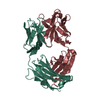 4kvcC M: map data used to model this data C: citing same article ( |
|---|---|
| Similar structure data |
- Links
Links
- Assembly
Assembly
| Deposited unit | 
|
|---|---|
| 1 | x 60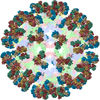
|
| 2 |
|
| 3 | x 5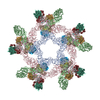
|
| 4 | x 6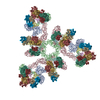
|
| 5 | 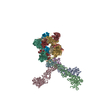
|
| Symmetry | Point symmetry: (Schoenflies symbol : I (icosahedral : I (icosahedral )) )) |
- Components
Components
| #1: Protein |  / Coordinate model: Cα atoms only / Coordinate model: Cα atoms onlyMass: 43400.898 Da / Num. of mol.: 3 / Fragment: UNP residues 281-675 / Source method: isolated from a natural source / Source: (natural)   Dengue virus 2 / References: UniProt: O11875 Dengue virus 2 / References: UniProt: O11875#2: Protein | Mass: 9261.531 Da / Num. of mol.: 3 / Fragment: UNP residues 1-81 / Source method: isolated from a natural source / Source: (natural)   Dengue virus 2 / References: UniProt: Q3BCY5 Dengue virus 2 / References: UniProt: Q3BCY5#3: Antibody | Mass: 23696.553 Da / Num. of mol.: 3 / Fragment: SEE REMARK 999 Source method: isolated from a genetically manipulated source Source: (gene. exp.)   Mus musculus (house mouse) / Gene: Igh-1a, Igh / References: UniProt: P01783, UniProt: Q6PIP8 Mus musculus (house mouse) / Gene: Igh-1a, Igh / References: UniProt: P01783, UniProt: Q6PIP8#4: Antibody | Mass: 23355.746 Da / Num. of mol.: 3 / Fragment: SEE REMARK 999 Source method: isolated from a genetically manipulated source Source: (gene. exp.)   Mus musculus (house mouse) / Gene: Gm16939 / References: UniProt: P01634, UniProt: Q7TS98 Mus musculus (house mouse) / Gene: Gm16939 / References: UniProt: P01634, UniProt: Q7TS98Sequence details | 2H2 HEAVY CHAIN FAB IS A CHIMERA COMPRISING RESIDUES 17-119 OF UNP P01783 AND RESIDUES 120-230 OF ...2H2 HEAVY CHAIN FAB IS A CHIMERA COMPRISING | |
|---|
-Experimental details
-Experiment
| Experiment | Method:  ELECTRON MICROSCOPY ELECTRON MICROSCOPY |
|---|---|
| EM experiment | Aggregation state: PARTICLE / 3D reconstruction method:  single particle reconstruction single particle reconstruction |
- Sample preparation
Sample preparation
| Component | Name: High-concentration Fab Fragment of 2H2 antibody binding to immature Dengue virus at pH 7 Type: VIRUS Details: Three Fab fragments bind to three pr on each trimeric spike |
|---|---|
| Details of virus | Empty: NO / Enveloped: YES / Host category: INVERTEBRATE / Isolate: STRAIN / Type: VIRION |
| Natural host | Organism: Aedes albopictus / Strain: C6-36 |
| Buffer solution | Name: 100 mM phosphate buffer / pH: 7 / Details: 100 mM phosphate buffer |
| Specimen | Embedding applied: NO / Shadowing applied: NO / Staining applied : NO / Vitrification applied : NO / Vitrification applied : YES : YES |
| Specimen support | Details: Quantifoil 200 mesh |
Vitrification | Instrument: HOMEMADE PLUNGER / Cryogen name: ETHANE / Temp: 100 K / Details: Plunged into liquid ethane (homemade plunger) |
- Electron microscopy imaging
Electron microscopy imaging
| Microscopy | Model: FEI/PHILIPS CM200FEG / Date: Apr 7, 2011 |
|---|---|
| Electron gun | Electron source : :  FIELD EMISSION GUN / Accelerating voltage: 200 kV / Illumination mode: FLOOD BEAM FIELD EMISSION GUN / Accelerating voltage: 200 kV / Illumination mode: FLOOD BEAM |
| Electron lens | Mode: BRIGHT FIELD Bright-field microscopy / Nominal magnification: 50000 X / Calibrated magnification: 51040 X / Nominal defocus max: 5000 nm / Nominal defocus min: 2000 nm / Cs Bright-field microscopy / Nominal magnification: 50000 X / Calibrated magnification: 51040 X / Nominal defocus max: 5000 nm / Nominal defocus min: 2000 nm / Cs : 2 mm : 2 mmAstigmatism  : Objective lens astigmatism was corrected at 100,000 times magnification : Objective lens astigmatism was corrected at 100,000 times magnificationCamera length: 0 mm |
| Specimen holder | Specimen holder model: GATAN LIQUID NITROGEN / Temperature: 100 K / Temperature (max): 105 K / Temperature (min): 80 K / Tilt angle max: 0 ° / Tilt angle min: 0 ° |
| Image recording | Electron dose: 25 e/Å2 / Film or detector model: KODAK SO-163 FILM |
| Image scans | Num. digital images: 49 |
| Radiation | Protocol: SINGLE WAVELENGTH / Monochromatic (M) / Laue (L): M / Scattering type: x-ray |
| Radiation wavelength | Relative weight: 1 |
- Processing
Processing
| EM software |
| ||||||||||||||||||||
|---|---|---|---|---|---|---|---|---|---|---|---|---|---|---|---|---|---|---|---|---|---|
CTF correction | Details: Film | ||||||||||||||||||||
| Symmetry | Point symmetry : I (icosahedral : I (icosahedral ) ) | ||||||||||||||||||||
3D reconstruction | Method: projection matching / Resolution: 21 Å / Resolution method: FSC 0.5 CUT-OFF / Num. of particles: 378 / Nominal pixel size: 3.72 Å / Actual pixel size: 3.72 Å / Details: (Single particle--Applied symmetry: I) / Symmetry type: POINT | ||||||||||||||||||||
| Atomic model building | Protocol: RIGID BODY FIT / Space: REAL / Details: REFINEMENT PROTOCOL--rigid body | ||||||||||||||||||||
| Atomic model building |
| ||||||||||||||||||||
| Refinement step | Cycle: LAST
|
 Movie
Movie Controller
Controller



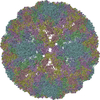
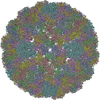

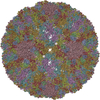

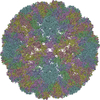
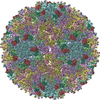

 PDBj
PDBj



